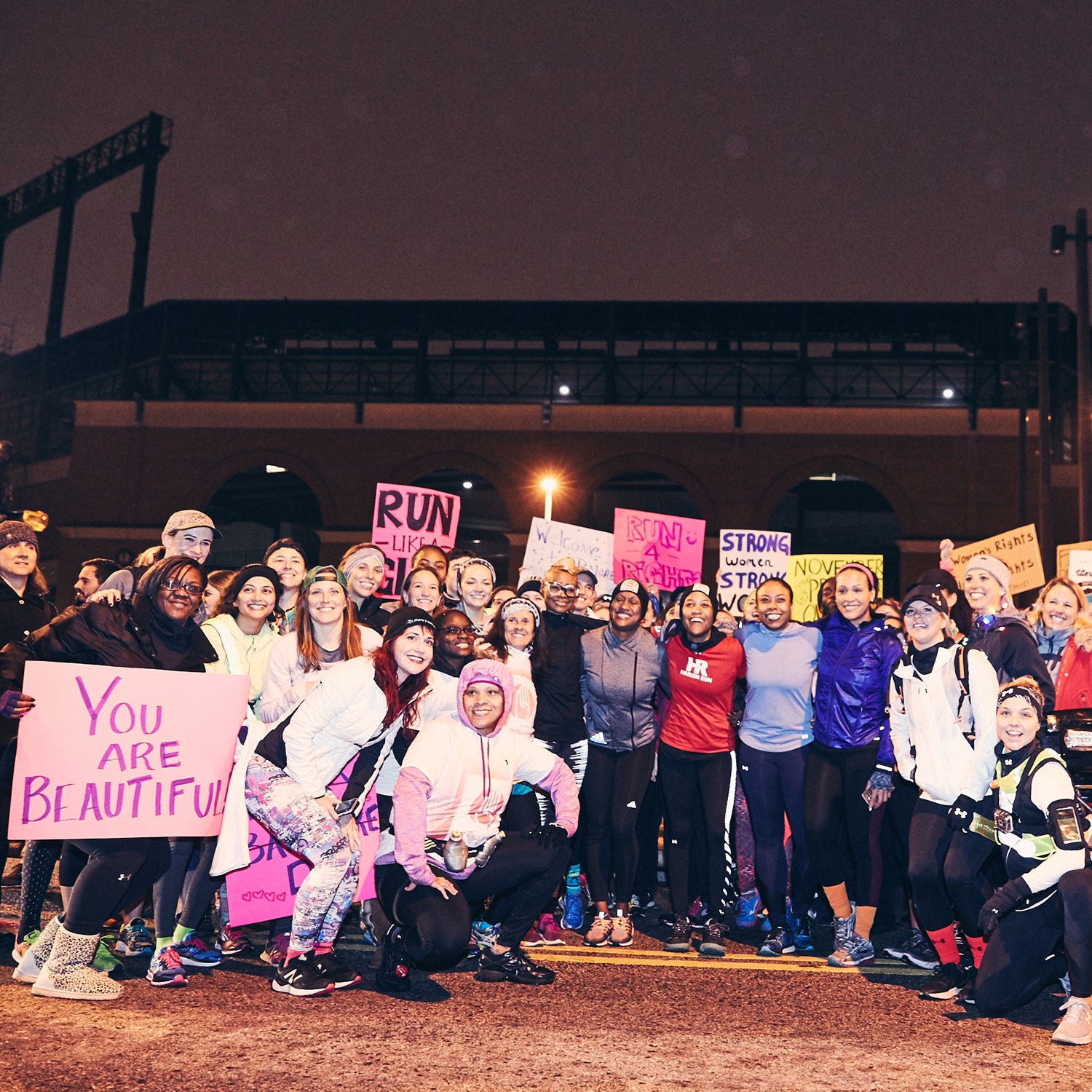It started with an offhand comment: last year, Oiselle’s Head of Corporate Development,��, suggested running a coast-to-coast relay with the brand’s , a membership-based running community. While that idea was brushed off, it planted a seed. With an election year coming up, what if there were��a long-distance relay designed to get out the vote, specifically among women, while also commemorating the 100th anniversary of a woman’s right to vote?��
From there, the brand reached out to activist and the collective , and the idea for Womxn Run the Vote was born. While the concept was formed by those conversations within Oiselle, the actual development of the relay came from Désir and Run 4 All Women.��Désir has a lot of experience combining running and social movements: in 2017, she and three other women ran from Harlem, New York,��to Washington, D.C. for the Women’s March, raising over $100,000 for Planned Parenthood. Run 4 All Women organized a similar relay before the Midterm elections in 2018. (When Oiselle and Désir began discussing the relay, Désir was sponsored by another brand. Since then, she has joined Oiselle as an athlete-advisor.)
This week, teams of 15 to 20 runners will take��part in a 680-mile virtual relay from Atlanta, Georgia,��to Washington, D.C. With 10,000 registered participants, the event raised over $260,000 for , an organization dedicated to increasing the power in marginalized, predominantly Black communities.��
The COVID-19 pandemic added an unexpected hurdle to planning what was supposed to be an in-person event. Organizers had a few months to figure out how to transition the relay to the virtual world. They settled on using the online platform : teams complete their miles anywhere and log them on the site or app. Racery traces the team’s progress on a map as they make their way—virtually—to Washington, D.C. Teams also pass pin-drops marking historical sites along the route, triggering emails with educational information.
But the relay is more than just a get-out-the-vote campaign. It acknowledges the rich, complicated history of the women’s suffrage movement and forges a new pathway for inclusive feminism.��
There’s a strong precedent for centering long-distance running around the women’s movement. , assistant professor at Cal State Fullerton, says that running is a “mode of public address.” People often use their bodies to make arguments, and movement and non-violent protests were a key strategy in the civil rights movement, from marches to sit-ins. Then and now, the physical act of running��is also disruptive to the notion that women shouldn’t participate in sports.
In 1977, organizers of the National Women’s Conference capitalized on this idea. In the lead-up to the conference in Houston, Texas, more than 2,000 people took part in the , including��Boston Marathon legend��Kathrine Switzer, former tennis pro��Billie Jean King, and women’s��movement activist��Bella Abzug, along with high school and college cross-country teams. The six-week, 2,612-mile trek from Seneca Falls, New York (the birthplace of the women’s suffrage movement in 1848) to Houston was designed to celebrate the successes of the women’s movement, from suffrage to Title IX. As Samek��, “Runners literally and figuratively passed the torch from one era in feminist history to another.”��
But Samek says the idea of Seneca Falls as the origin of feminism is problematic. “It narrows the focus to this particular group of people, most of whom were white,” she says. While the 19th amendment��is celebrated for securing a woman’s right to vote, ��that all women were guaranteed a right to vote. The women’s suffrage movement excluded women of color and women in the LGBTQ+ community from the movement.
Even though organizers of the 1977 Conference and Torch Relay leaned heavily into the idea of multiculturalism, it wasn’t idyllic, says , assistant professor at Penn State University and co-host of the . For example, organizers hand-picked to run the final mile: , a white marathoner; Sylvia Ortiz, a Latina volleyball player from the University of Houston; and Michelle Cearcy, a Black woman from Houston. While on the surface it’s a diverse image, in all the pictures, Kokernut stands in the middle, with Ortiz and Cearcy flanking her—symbolic of white feminism. (And only Kokernut’s photo eventually appeared on .) Davis says organizers often got Cearcy’s name wrong too, calling her Wilma Rudolph and the names of other Black women, as if they were all interchangeable. “In terms of what it actually means to be inclusive of women of color, they still had a long way to go,” she says.
In many ways, Womxn Run the Vote builds on the Houston relay and re-imagines what an inclusive women’s movement could look like. Lauren Fleshman, Oiselle athlete-advisor, says that was deliberate. “Let’s revisit and learn from the 1977 Torch Relay��and move it forward in a way that’s relevant to issues happening today,” she says of their thought process. “How can we do this relay that’s symbolic of the next 100 years of voting?”
The team behind Womxn Run the Vote has been intentional in all stages of their planning. “The real power lies in where you put the route and whose stories get told. That’s where racism and white privilege sinks in, where white people generally pick the spaces and tell the stories,” Fleshman says. “But you’re not going to identify the best routes and the most powerful stories that way. We need to center the most marginalized voices in the feminist space in order to push the feminist agenda forward.”��
Instead of a cross-country journey, they selected a route along the . It was important to the organizers that the new relay took into account intersectionality—a framework, coined by UCLA and Columbia Law School professor Kimberlé Crenshaw in 1989, that considers overlapping identities (such as race, class, gender identity, sexual orientation, religion) and how they interact and converge to create systems of privilege and discrimination. The virtual pin drops highlight the history of the Civil Rights movement,��specifically women of color and Black women leaders. , a Run 4 All Women ambassador who has taken the lead in curating the stories, sees these lessons as a starting point for further education. “I hope people will read these stories and be inspired to look into them more. There are some amazing stories of resistance happening in the South and they definitely don’t get as much shine as they should,” she says.
Davis says the relay creates a space for people who’ve been fumbling with the idea of how to engage in politics, and creates a path to think about a sport like running as political. “This is a way where you can say, when I’m running, I can run with my politics,” she says. “It’s disruptive to this notion that these two things are somehow separate.”��Participants don’t just have to run either: they can log to count towards their miles, making it accessible to a wider range of people.��“By making it virtual, by widening the accessibility, by centering on Civil Rights and Black womanhood, by donating to Black Voters Matter, it’s��espousing an evolving vision of what it means to think about women as political actors,”��Davis says. “That’s so significant because too often Black women, and women of color in general, have been overlooked as political players.”��
The relay also offers participants a practice that’s familiar to runners and applicable to the anti-racism journey: runners know how to split up��a long distance into small steps, put in the work, and be changed by the process. “Can we use this relay to help translate that same skill set to anti-racism work?” Fleshman asks. Désir likens the process to marathon training. “It seems completely impossible, but when you break it down to a 12-, 14-, or 16-week training plan and run with other people, suddenly it feels like a breeze,” Désir says. “It’s using that idea to show people you’re powerful when you link arms with other folks.”
And each individual step can make a collective difference in the long term. “We’re looking at this as Civil Rights 2.0, seeing how we’re going to make an impact and also changing what it means to be active and to be an activist,” says , a Run 4 All Woman ambassador. “The power is knowing that regardless of how small my role is, there is a ripple effect.”


